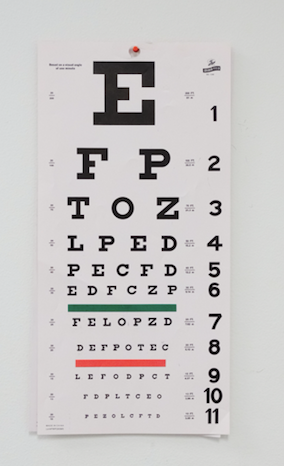2020 Optometry EHR Market Share (Pending Results)

| By AOA AOA New Technology & EHR Survey New Technology & EHR Usage Among Optometrists |
| The 2015 New Technology & EHR Survey was conducted in the rst quarter of 2015 to gather data on the current usage and awareness of technologies available for the optometric practice. The survey collected information on the clinical use of technology, practice management use of technology, meaningful use of electronic health record systems (EHR), and use of internet technology by practicing optometrists. Respondents answered questions based on the current use of technology within their primary practice, or their intent to acquire technology for the practice within the upcoming year. The survey was sent to a random strati ed sample of professionally active optometrists; the sample was drawn from AOA membership records, state board of optometry license les, and the National Provider Index database. Data collection was completed in May 2015. The sample was adjusted by removing optometrists who were retired, deceased, or not locatable. The nal adjusted overall response rate was 10% with an error level of +/- 4.4% at the 95% level of con dence. About the 2015 New Technology & EHR Survey The full report, 2015 New Technology & EHR Usage among Optometrists, provides descriptive statistics on the use of technology and EHR systems by optometrists in 2014. Equipment usage and components of practice management software utilized by optometrists is compared to utilization reported in previous surveys conducted between 2003 and 2014. Meaningful use of EHR is compared to data reported on the 2010 EHR Survey and the 2011-2014 New Technology & EHR Surveys. The full report may be obtained by contacting the AOA Order Department by phone (888.262.2210) or by visiting the web site at: aoa.org/marketplace. |
|
ELECTRONIC SYSTEMS UTILIZED IN
PRIMARY PRACTICE OF OPTOMETRISTS
Survey participants were asked which electronic system
they currently use in their primary practice. Electronic
systems were identi ed as:
1. Practice management systems—electronic software
packages that track and maintain information such as:
patient demographics, scheduling, billing, insurance, and
recall;
2. Patient health information systems—electronic
software packages that maintain health information such
as: exam data, testing, images and prescriptions; and
3. Complete EHR—electronic system comprised of both
practice management and patient health information
systems.
Sixty-six percent of responding optometrists have
adopted a complete EHR in their primary practice, a three percent increase from 2014 and the highest reported percentage since 2010. AOA-member optometrists are signi cantly more likely to use a complete EHR in their practice (71%) as compared to non-members (45%). Employment situation was also shown to have an impact on EHR use, with more non- solo-owners reporting EHR use (72%) than either solo owners (58%) or non-owners (67%). The use of practice management systems only decreased from 27% in 2014 to 26% in 2015. Two percent of respondents are using patient management systems only, a decrease from ve percent in 2014. Six percent of respondents are not using any of the three electronic systems. Of the respondents who report using a complete EHR system, more than a third (33%) report using Of ceMate, followed by CompuLink (12%), RevolutionEHR (11%) and First Insight (Maxim Eyes) (7%). Seventy-two percent of responding EHR users report initially implementing their EHR system in their primary practice in 2012 or earlier. Eighty-seven percent of respondents are using the same EHR system originally purchased for implementation. Of optometrists who have the same system that was initially implemented, 77% report overall satisfaction with their system. Thirteen percent report replacing their initial EHR system; of these, 74% report overall satisfaction with their new EHR. Current EHR users were also asked to report on the bene ts of their implemented systems. The majority of responding optometrists (65%) selected “access patient chart remotely”, “enhanced overall patient care” (48%) and “improved patient education” (38%) as bene ts they personally experience with EHR use. With higher numbers of overall EHR users, it is no © 2015 American Optometric Association RESEARCH AND INFORMATION CENTER 1 |
2015 AOA New Technology & EHR Survey
New Technology & EHR Usage Among Optometrists
surprise that electronic prescriptions continue to
increase in use among optometrists, from 15% in
2011 to 47% in 2015. EHR users remain signi cantly
more likely to electronically prescribe medications
and report electronically prescribing 73% of total
medication prescriptions in the last year. Although the
majority of optometrists continue to provide handwritten
medication prescriptions, the percentage of total medication prescriptions handwritten by optometrists has decreased substantially, from 60% of total medication prescriptions in 2011 to 38% in 2015. Non-EHR users report electronically prescribing eight percent of total prescriptions provided to patients.*
2
© 2015 American Optometric Association
RESEARCH AND INFORMATION CENTER
2015 AOA New Technology & EHR Survey
New Technology & EHR Usage Among Optometrists
MEANINGFUL USE IN 2015
Beginning with the 2015 New Technology and EHR Survey, the AOA changed the way in which survey respondents were asked about their meaningful use of electronic health record systems. The meaningful use objectives were divided into four sections:
Stage 1 Core Objectives Stage 1 Menu Objectives Stage 2 Core Objectives Stage 2 Menu Objectives
Unlike previous years, respondents in 2015 are only able to choose one of two options to describe their meaningful use activity: “Attest to use” or “I will report an exclusion for this measure.”
The 2015 Stage 1 objectives were comprised of 13
core measures and 9 menu measures. EPs must report
on all 13 of the core measures and 5 out of 9 menu
measures, with at least 1 public health measure selected.
The 2015 Stage 2 objectives were comprised of 17
core measures and 6 menu measures. EPs must report
on all 17 of the core measures and 3 out of 6 menu
measures.
For all responding optometrists attesting to Stage 1 Core Set Objectives, the majority used their EHR systems to “record smoking status for patients 13 years or older,” (95%) and “provide clinical summaries for patients
for each of ce visit” (84%). The highest percentage
of optometrists reported an exclusion to “record and
chart changes in vital signs” (41%) and an exclusion to
“provide patients the ability to view online, download,
and transmit their health information within 4 business days of the information being available to the EP” (36%).
More than eight of ten responding optometrists attesting
to Stage 1 Menu Set Objectives report using their
EHR systems to: “send reminders to patients per
patient preference for preventive/follow-up care” (87%),
“implement drug formulary checks” (84%), and “provide
summary care record for each transition of care or
referral” (84%). The majority of respondents reported
an exclusion for “capability to submit electronic data
to immunization registries or immunization information
systems, except where prohibited, and actual submission
in accordance with applicable law and practice” (67%)
and “capability to submit electronic syndromic surveillance
data to public health agencies and actual submission,
except where prohibited, in accordance with applicable
law and practice” (58%).
Respondents attesting to Stage 2 Core Set Objectives overwhelmingly reported using their EHR systems to “record smoking status for patients 13 years old or older” (99%) and “provide clinical summaries for patients for each of ce visit” (98%). The majority of these respondents reported exclusions for “capability to submit electronic data to immunization registries or immunization information systems except where prohibited, and in accordance with applicable law and practice” (69%)
and “incorporate clinical lab-test results into CEHRT as structured data” (60%).
For responding optometrists attesting to Stage 2 Menu Set Objectives, the majority used their electronic health records systems to “record electronic notes in patient records” (98%) and “record patient family health history as structured data” (97%). The highest percentage of respondents reported exclusions for “capability to identify and report speci c cases to a specialized registry (other than a cancer registry), expect where prohibited, and in accordance with applicable law and practice” (63%) and “capability to submit electronic syndromic surveillance data to public health agencies and actual submission, except where prohibited, in accordance with applicable law and practice” (59%).
Nearly half of the responding optometrists (49%) plan
to achieve Stage 2 Meaningful Use and attest in 2015,
as compared to only 17% who plan to achieve Stage 1
Meaningful Use and attest in 2015. More than one third
(33%) are not planning to achieve MU at this time.
3
© 2015 American Optometric Association
RESEARCH AND INFORMATION CENTER
| 2015 AOA New Technology & EHR Survey New Technology & EHR Usage Among Optometrists CLINICAL USE OF TECHNOLOGY Three-fourths of optometrists (75%) report current use of an automated perimeter in their primary practice. More than one half of responding optometrists currently utilize an automated perimeter (74%), fundus photography (72%), pachymeters (52%), and a scanning laser ophthalmoscope (50%). Macular Pigment Optical Density (MPOD) devices (4%) and vascular imaging to test for blockage/ ow (2%) were the least utilized equipment for the sixth year in a row. In addition to indicating which listed equipment the optometry practice plans to acquire, respondents were asked to list any additional equipment they plan to purchase or lease in 2015. The most frequently reported equipment planned for purchase or lease in 2015 are: OPTOS (16%); OCT (14%); exam lanes (13%); visual elds (8%); tonometers (5%); and slit lamps (5%). Eighty-eight percent of optometrists do not currently use an image management system (IMS) and only six percent plan to acquire an IMS within the next year. The majority of optometrists (64%) plan to spend less than $10,000 on clinical equipment in 2015. Twenty-seven percent plan to spend between $10,000 and $49,999; nine percent plan to spend more than $50,000. Clinical equipment purchases have also shown some impact on practice pro tability; 67% percent of optometrists feel that their clinical equipment purchases have increased pro tability over the past three years. Only four percent of responding optometrists perceived their equipment purchases have somewhat decreased practice pro tability. |
| Respondent Demographics Seventy-six percent of respondents were practicing in major metropolitan areas, 15% were practicing in micropolitan areas (population more than 10,000 but less than 50,000) and 9% were practicing in rural areas. The majority (30%) of respondents were located in the Midwest, 16% in the Northeast, 28% in the South and 26% in the West. Nearly two out of three (65%) of respondents were male and 35% were female. The majority of respondents (73%) indicated the¬ir primary practice type was private practice, 13% were in corporate practices and 14% were in other practice types such as employees of ophthalmologists, hospitals or educational institutions. The majority of optometrists in private practice (88%) were owner optometrists and 12% were employees. Optometrists who have been in practice for more than 31 years accounted for a third (33%) of respondents. Twenty-six percent have been in practice for 21 to 30 years, 21% have been in practice for less than 10 years, and 20% for 11 to 20 years. The average age of respondents was 50 years and the average number of years in practice was 23 years. |


